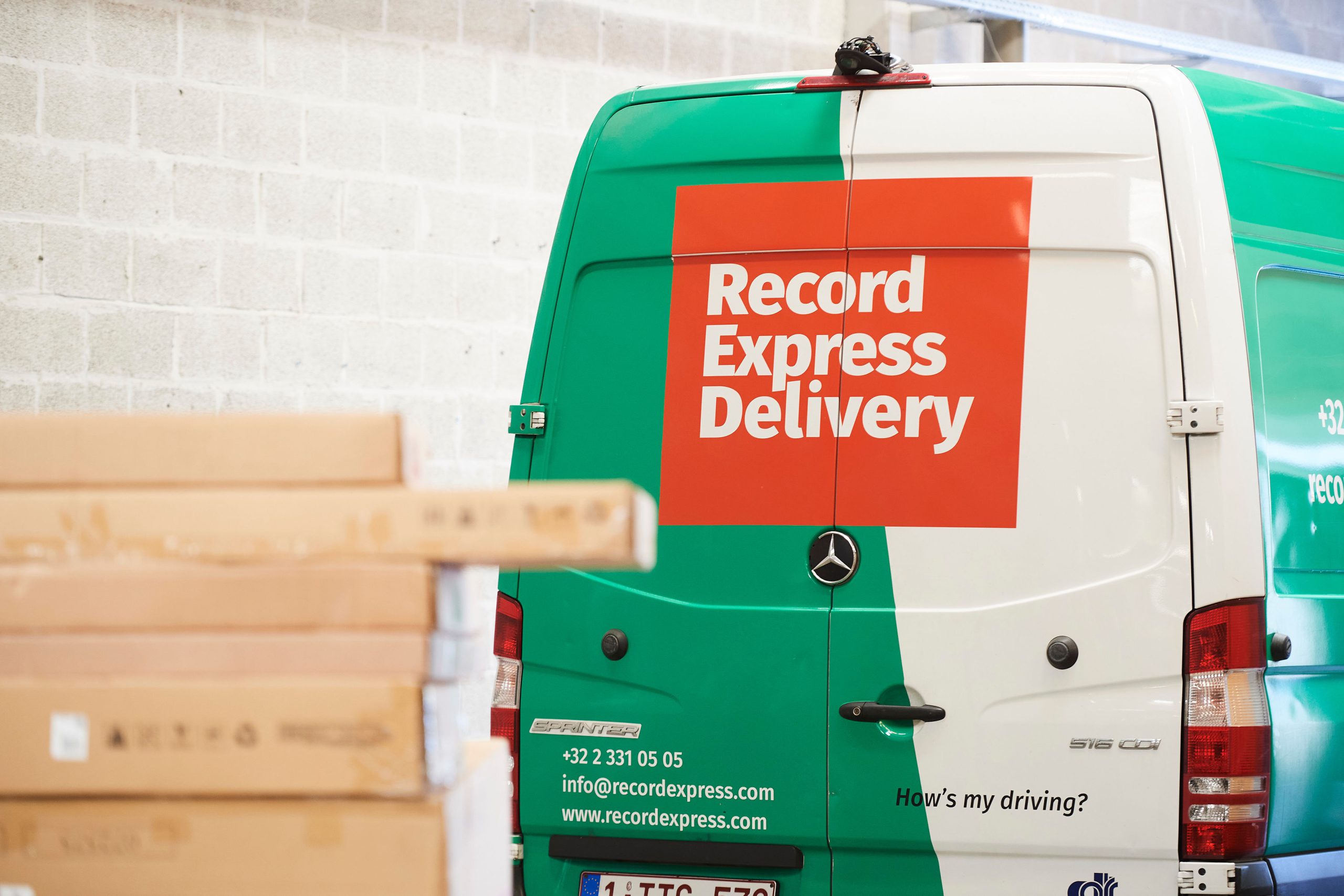Last-Mile for Industrial Deliveries: Machinery, Equipment, and Tools
Last-mile delivery solutions for industrial machinery and tools. SEND PARCELHome / Our Business Areas / Industry / Last-Mile for Industrial Deliveries: Machinery, Equipment, and Tools

Industrial last-mile is not parcel delivery with bigger boxes. It’s precision movement of heavy, high-value assets into live plants, warehouses, and construction sites—often through restricted access and low-emission zones. Success depends on surveyed access, correct lifting gear, trained two-person or four-person crews, LEZ-compliant routing, and photo-verified placement. Record Express delivers this with own-fleet control, specialist handling equipment, and KPI reporting tailored to Belgian industrial environments.
Related guides:
Warehouse-to-Site Logistics ·
Construction Site Delivery Coordination ·
Eco-Friendly Last-Mile Delivery
Why is industrial last-mile different from standard B2C or retail?
Direct answer: Because machinery and tools are heavy, fragile in specific ways, and operationally critical. You’re not moving “a package”—you’re protecting uptime for a plant or job site.
Industrial last-mile in Belgium often involves narrow urban approaches, LEZ restrictions, and multilingual crews. Loads range from compact power tools to 1-3 tonne machines with offset centres of gravity. Many sites run live operations: forklifts, pedestrians, and fixed shift windows. The logistics objective is more than arrival; it’s safe positioning at the exact point of use with proof that condition is intact. That requires pre-surveyed access, selection of the right lifting method (tail-lift, pallet truck, skates, gantry, or crane), and a risk-assessed route from truck to final position. Done right, crews step through gates without disrupting production, quality teams sign off on the ePOD, and finance can invoice immediately. Done poorly, you get damage, delays, and safety incidents. The difference is process, not luck.
What are the core workflow stages for industrial last-mile?
Direct answer: Plan → Survey → Stage → Load → Deliver → Position → Verify. Each stage removes a class of risk so the next one runs cleanly.
Planning collects technical data and timing constraints. The site survey validates door widths, slopes, floor loads, and lift capacities. Staging groups parts by installation sequence. Loading locks each item to prevent shift and protects edges and lifting points. Delivery uses compliant routes and reserved bays. Positioning is the controlled movement inside the site using the agreed method and crew size. Verification closes with photos, measurements if required, and signatures. A single digital trail ties them together for audit and customer assurance.
| Stage | Goal | Key inputs | Failure risk if weak | Control |
|---|---|---|---|---|
| Plan | Define scope, timing | SOW, weight & dims, site contact | Wrong gear or crew size | Pre-job checklist + approvals |
| Survey | Validate access path | Photos, measurements | Blocked or unsafe route | Measured drawing + go/no-go |
| Stage | Sequence parts & tools | Staging manifest | Re-handling, missing items | Colour-coded kits |
| Load | Immobilise & protect | Straps, bars, blankets | Shift and damage | Photo before door close |
| Deliver | Meet slot & rules | Route plan, LEZ status | Refusal or fines | EV/Euro-6 + booked bay |
| Position | Place at point of use | Skates, tail-lift, gantry | Injury, floor damage | Trained crew + floor guards |
| Verify | Close with proof | ePOD, photos, variance | Disputes and delays | Same-day digital sign-off |
Which equipment categories need special handling?
Direct answer: Machines with high centres of gravity, sensitive surfaces, or fragile components; long-profile items; and calibrated instruments all require custom controls.
Category matters more than weight. A 300 kg cabinet with a narrow base can be riskier than an evenly distributed 600 kg crate. Stainless or painted surfaces demand non-abrasive protection. Long profiles bend without mid-supports. Instruments may need shock indicators and “tip-n-tell” labels. The safest approach is to map each category to a lifting and packaging method, and then train crews on failure modes—what actually goes wrong in the last ten metres. That discipline keeps damage rates under control without slowing the job.
| Category | Typical risk | Handling method | Packaging |
|---|---|---|---|
| High-CG cabinets | Tip-over | Skates + spotters | Edge bars + blankets |
| Precision instruments | Shock/vibration | Foam cradles; no drop | Shock & tilt indicators |
| Long profiles | Bending | Two-point carry | Centre supports |
| Painted steel | Scratches | Soft slings | Non-abrasive separators |
| Glass panels | Edge chips | A-frame; vertical | Corner guards + sleeves |
How do you plan access, lifting, and site safety?
Direct answer: Start with a measured access path and a lifting plan that respects floor loads, slopes, and turning circles; then brief the crew on PPE and spotter roles.
Access planning is a technical task, not guesswork. Measure door widths and heights, note steps and lips, and check lift capacities. Use floor guards in offices and epoxy floors in plants to prevent scuffs. Select lifting gear based on the heaviest or most awkward item, not the average. Where crane or hoist access is required, confirm street permits and time windows. Finally, deliver a concise toolbox talk: hazards, responsibilities, and hand signals. Industrial last-mile is safe when everyone knows their movement pattern before wheels roll.
What scheduling model keeps production and projects on time?
Direct answer: Sequence deliveries to the job programme, hold short windows, and keep a flexible recovery slot. For city cores, stage outside the LEZ and shuttle in compliant vehicles.
Belgian plants and construction sites run tight shifts. The most reliable pattern is a rolling 10-day look-ahead with daily reconfirmation of the next 48 hours. Book bays and lifts; publish plate numbers and driver names the day before; and provide live ETAs in the site language. When weather or crane delays hit, a predefined recovery slot prevents knock-on effects. For dense city centres, suburban micro-staging with EV or Euro-6 vans inside the LEZ keeps timing precise and avoids penalties. The goal is to arrive, position, and leave with minimal footprint.
How do sustainability and LEZ compliance affect industrial last-mile?
Direct answer: LEZ rules limit vehicle choice; the practical response is EV or Euro-6 vans for final legs, route compression, and reusable protection instead of single-use packaging.
Brussels, Antwerp, and Ghent enforce progressively stricter entry for older diesel vehicles. Industrial consignments can still be sustainable with smart routing, consolidated loads, and minimal re-handling. Reusable blankets, crates, and edge bars cut waste and protect surfaces better than cardboard. For ESG reporting, publish a simple intensity metric—CO₂ per tonne-kilometre delivered—and show year-on-year reduction. Sustainability becomes an efficiency lever when embedded into the workflow rather than added at the end.
How should packaging and load security be set for heavy/odd loads?
Direct answer: Immobilise first, then protect. Use multi-height straps, edge bars, anti-slip mats, and “no-stack” logic unless crates are designed for stacking.
Load planning starts with centre-of-gravity and restraint points. Tall items travel hard against rails with straps at top and mid-height. Loose parts are bagged and taped to the parent unit. Use anti-slip mats under skids and separate painted surfaces with soft separators. If a crate is rated for stacking, keep the heaviest at the bottom and place load labels where crews can see them during handling. Photograph the finished load before door close; that single image resolves most damage disputes.
| Risk | Cause | Control |
|---|---|---|
| Shift in transit | Insufficient restraint | Two straps + edge bars |
| Surface scuffs | Friction or rubbing | Blankets + non-abrasive separators |
| Bent profiles | Unsupported span | Mid-supports and “no overhang” rule |
| Missing parts | Loose accessories | Accessory bags taped to parent unit |
What about reverse logistics—returns, swaps, and service parts?
Direct answer: Build a reverse flow with the same discipline as forward delivery: inspect at pickup, log condition with photos, repack for safe travel, and consolidate backhauls to cut cost.
Industrial programmes rarely end at installation. Warranty swaps, refurb returns, and service parts must travel safely and predictably. Use the same ePOD trail in reverse with variance notes and barcodes. For high-value components, apply sealed custody and GPS-tracked movement. Consolidated backhauls from sites and plants keep costs under control and reduce empty miles. When reverse logistics is built into the plan, service SLAs improve and customers see issues resolved without argument.
Which KPIs prove control of industrial last-mile operations?
Direct answer: On-time to slot, first-attempt success, damage rate, touches per item, ePOD cycle time, and CO₂ intensity per tonne-km. Track them daily; publish weekly.
These KPIs align dispatch, site teams, and finance. Targets vary by sector, but most Belgian industrial programmes aim for ≥98% on time, ≤0.5% damage, and same-day ePOD close. Converting data into a traffic-light dashboard makes exceptions stand out so managers can act early.
| KPI | Target | Why it matters |
|---|---|---|
| On-time to slot | ≥ 98% | Protects site schedules and crew time |
| First-attempt success | ≥ 95% | Avoids re-delivery costs |
| Damage rate | ≤ 0.5% | Preserves margins and trust |
| Touches per item | ≤ 3 | Fewer touches = fewer defects |
| ePOD cycle time | Same day | Enables same-day invoicing |
| CO₂ intensity | YoY reduction | Meets sustainability commitments |
How does Record Express differentiate in Belgian industrial last-mile?
Direct answer: Own fleet, trained crews, specialist handling gear, LEZ-ready routing, and photo-verified placement—wrapped in clear KPIs and bilingual coordination.
Record Express pairs heavy-item handling with tight urban discipline. Our vehicles carry blankets, edge bars, anti-slip mats, skates, and tail-lifts as standard; gantries and cranes are arranged when required. We pre-survey sites, stage by sequence, and operate EV/Euro-6 legs inside LEZ zones. Communication is multilingual, and every delivery closes with ePOD photos and variance notes. Clients use our daily dashboards to track on-time performance, damage rates, and emissions intensity. That’s why manufacturers, facility teams, and contractors across Belgium use Record Express when machinery and tools must arrive on time and ready to work.
Talk to Record Express about site surveys, LEZ-compliant routes, and photo-verified placement across Belgium.
FAQ
Can you place machines at the exact point of use?
Yes. We survey access, choose the lifting method (tail-lift, skates, gantry, crane), protect floors, and position safely with photo proof on completion.
Are your vehicles approved for Belgian LEZ zones?
We operate EV and Euro-6 vehicles and plan micro-staged shuttles for city-centre deliveries in Brussels, Antwerp, and Ghent.
Do you handle reverse logistics for swaps or returns?
Yes. We collect, inspect, repack, and consolidate backhauls with the same ePOD documentation and custody controls as forward deliveries.
Sources & Further Reading
- Record Express — Warehouse-to-Site Logistics
- Record Express — Construction Delivery Coordination
- Brussels Capital Region — Low Emission Zone

Record Express was awarded a 59/100 score by EcoVadis, the global leader in sustainability ratings.